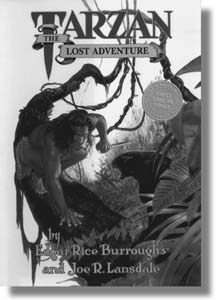Aping the Ape-man
Long after his death, Edgar Rice Burroughs returns with a brand-new Tarzan novel
By Andrew X. Pham
WITH THE RECENT rash of posthumous publications, putting a few chapters or an outline into a safe seems to be the best way to get a book published without doing too much of the work yourself. Also, your publisher will likely market it as one of your masterpieces.
Several decades after his death, Edgar Rice Burroughs, one of the kings of the pulps and grandfathers of science fiction, has a third posthumous novel, Tarzan: The Lost Adventure, on bookstore shelves.
Given the great hoopla surrounding this latest unearthing, Burroughs' own explanation of how he became the creator of Tarzan provides a useful perspective: "I had gone thoroughly through some of the all-fiction magazines and I made up my mind that if people were paid for writing such rot as I read, [then] I could write stories just as rotten ... just as entertaining and probably a lot more so" (from The Washington Post, Oct. 27, 1929).
Burroughs published his first Tarzan book, Tarzan of the Apes, in 1914, and, on average, hacked out about one Tarzan book every year until 1939. After an eight-year hiatus, Burroughs issued Tarzan and the Foreign Legion, his last Tarzan book (penned in his hand), in 1947.
The next two Tarzan books rolled off the press after Burroughs' death (1950), one in 1964 and the other in 1965. Another unfinished and untitled Tarzan typescript of 83 pages was discovered in Burroughs' safe, and the publishing vultures have been squawking over the find ever since.
However, not much happened for 30 years until Dark Horse Comics rustled up one Joe R. Lansdale to beef up the half-finished manuscript. With a strong stable of pulp-era-oriented artists, Dark Horse put out a nice four-part comic-book version in softcover. Sales pronounced it a resounding success, and Dark Horse rushed it out as a piece of hardcover fiction.
Lost City of Ur
IN THIS NEW/OLD TALE, Tarzan returns to his African jungle from England, where he has been living with his wife, Jane, under the alias of Lord Greystoke. Back home, Tarzan chances upon a scientific expedition that ran afoul of a murderous group of Foreign Legion deserters.
The Ape-man quickly becomes enmeshed in rescuing a beautiful damsel and her professorial father from the bad legionnaires, the dangers of the jungle, a monster from the world at the center of the Earth and the mad king of the lost city of Ur.
Lansdale imitates Burroughs not at his best but at his worst. If Lansdale has any talent as a writer, he has squandered all of it trying to emulate the Burroughs of the early years. In fact, Lansdale tried so hard that he often begins every other sentence with "Tarzan."
Sometimes he even succeeds in crafting pulpy blunders as perversely magnificent as Burroughs'. For instance, in the second half of the book (written entirely by Lansdale), he describes a fight scene: "The impact shattered the jailer's head like an overripe fruit, and the contents of this fruit sprayed the guards and the messengers, and in that instant, a blinking of an eye really, Tarzan swung the chains, one in either hand, fast and rhythmically, taking out heads and knees. In less than an instant, four men lay dead and two were bolting out of the dungeon and down the hall."
How Burroughs' 83-page manu-script became Lansdale's 200-page novel isn't as surprising as why Lansdale was permitted to contribute such rot to an innocent manuscript in the first place. Several convenient coincidences hurry the plot to a predictable ending. Worse, it's open-ended in such a way that other serials seem quite inevitable.
It's too bad that Lansdale (and Dark Horse) can't envision something greater. Although Burroughs' particular brand of fiction and his "golden age" have long faded with his passing, the Tarzan series will always have a sizable pubescent readership. Anyone toiling in the genre ought to have enough sense to write decently, so that at least these future writers won't be prematurely stunted.
Tarzan--the concept--still has merit as escapism entertainment for both the adult and the juvenile markets. But what the genre needs isn't someone who can ape Burroughs to a fault. It needs someone who can at least make Tarzan, well, intelligible to a modern age, and maybe not so much like a mechanical action-figure from a distant past.
[ Metro | Metroactive Central | Archives ]
This page was designed and created by the Boulevards team.

A Vine Madness: Tarzan takes on his teeth-baring jungle enemies one more time in "Tarzan: The Lost Adventure."
Tarzan: The Lost Adventure by Edgar Rice Burroughs and Joe R. Lansdale; Dark Horse Books; 211 pages; $19.95 cloth.
From the January 9-15, 1997 issue of Metro
Copyright © 1997 Metro Publishing, Inc.
![[Metroactive Books]](/books/gifs/books468.gif)